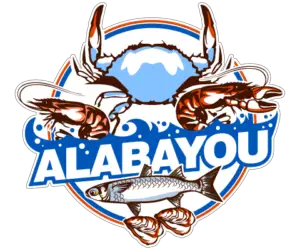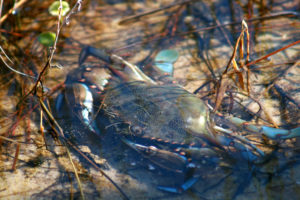Blue crabs are iconic creatures found along the Atlantic Coast and the Gulf of Mexico, cherished for their succulent meat and revered as both a fishery treasure and a critical member of the marine ecosystem.
Growing up in the heart of Bayou La Batre, Alabama, a fishing-centric community, I’ve witnessed the toils and triumphs of the crabbing world firsthand.
I often get asked “what do blue crabs eat?” These fascinating creatures have a voracious appetite, feeding on a varied diet that includes clams, oysters, mussels, smaller crustaceans, and even other young crabs.
Their adaptability spans habitats, from the saltiest gulf waters to the fresher back bays and estuaries, residing in the shallows up to depths of 120 feet.
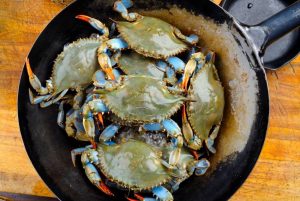
Blue Crab Diet: A Versatile Palate
Catching and Preparing Blue Crabs: An Art in Itself
Commercially, capturing blue crabs primarily involves baited traps or occasionally trawls and trotlines.
The process of preparing these crustaceans is an art, preserving the quality of the meat, cherished for its taste.
Discover the ultimate guide ‘Blue Crabs: Catch ’em, Cook ’em, Eat ’em’ by Peter Meyer, a comprehensive book offering insights into catching, cooking, and relishing blue crabs
Life Cycle and Habitat Preferences
Scientifically known as Callinectes sapidus, which translates to ‘beautiful savory swimmer,’ the blue crab holds a special place as the Maryland state crustacean and a coveted commodity in the Chesapeake Bay.
It’s a species vital to the marine ecosystem, acting as a major predator and prey.
These crabs have an intriguing life cycle, living for about 3-4 years, with maturity reached between 12-18 months, influenced by water temperature.
Mating, molting, and reproduction are crucial stages, with females producing between 750,000 to 3,200,000 eggs per brood.
Their native range spans from Nova Scotia to Argentina, encompassing a varied habitat of coastal waters.
Within the Chesapeake Bay, the blue crab displays habitat preferences based on sex and age, adapting to different salinity levels and depths.

Blue Crabs: Guardians of Coastal Ecosystems
Ecosystem Services: Balancing Act of Predators and Prey
Blue crabs, as apex predators, maintain balance in the ecosystem by controlling populations of various species.
They feed on smaller crustaceans and mollusks, preventing unchecked growth that could disturb the ecological equilibrium.
Habitat Diversity and Adaptability
Their adaptability to diverse habitats is remarkable. Blue crabs can thrive in different salinity levels, from the brackish waters of estuaries to the higher salinity of coastal areas.
Understanding their habitat preferences aids in preserving these crucial ecosystems.
Submerged Aquatic Vegetation: Blue Crab Hotspots
Submerged aquatic grasses serve as vital habitats for blue crabs. These areas are abundant in food sources and shelter, fostering a rich environment for the crabs to thrive.
Blue crabs, bottom-dwellers in submerged aquatic grasses, play a critical role in the Bay’s ecosystem, contributing to its diversity and balance.
Understanding these remarkable creatures sheds light on their significance in marine life and highlights their value in both culinary and ecological realms.
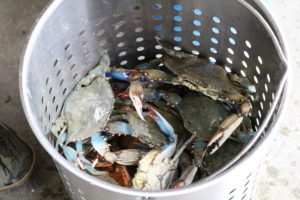
Blue Crabs in Regional Cuisines
In my home state of Alabama, the blue crab takes on a distinct cultural role in culinary traditions. One noteworthy dish is the West Indies salad, a flavorful concoction that embodies richness and zest.
Served chilled and often shared family-style, this dish represents a communal experience, usually enjoyed as an appetizer but sometimes relished as a hearty entrée.
The key to its taste lies in the quality of lump crabmeat, elevating the overall experience.
Coastal Delicacies: Blue Crab Culinary Treasures
In regions like Maryland and the Chesapeake Bay area, blue crabs are culinary icons. Dishes like crab cakes, crab boils, and steamed crabs showcase the delectable taste and culinary versatility of blue crab meat.
Experience the exceptional taste of Pontchartrain Blues Wild Caught Blue Crab Lump Meat—perfect for crafting delectable crab cakes or enhancing your West Indies salad. Try it for an authentic seafood delight
Local Cuisine: Blue Crab Delights Across America
Beyond Maryland, various regions have unique ways of preparing blue crabs.
Louisiana’s spicy Cajun crab boils, Florida’s crab-stuffed avocado, or the Carolina coast’s crab dip are examples of regional adaptations of this seafood gem.
Explore Alabayou’s recommended cooking equipment, from top-notch crab pots to essential crab crackers and specialized tools designed for handling delicious blue crabs.

Supporting Local Fisheries and Culinary Heritage
The significance of blue crab isn’t solely in its taste but also in its economic and cultural importance.
Buying domestic blue crab and crab meat supports local fisheries and sustains the livelihoods of coastal communities. Moreover, it honors a culinary heritage, preserving traditional recipes and methods passed down through generations.
Blue crabs hold a special place in various regional cuisines across the United States, each celebrating this marine bounty in its unique way.
Exploring these culinary traditions not only tantalizes the taste buds but also honors the cultural fabric woven around this cherished crustacean.
Cultural Heritage: Crabbing Traditions
In many coastal communities, crabbing is not just an occupation; it’s a way of life.
Generations have passed down crabbing traditions, creating a cultural legacy tied to the sea.
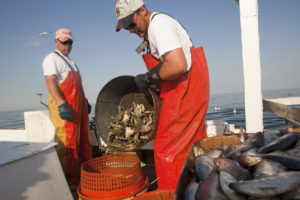
Festivals and Celebrations: Honoring the Blue Crab
Numerous festivals and events celebrate the blue crab, bringing communities together to revel in the cultural significance and culinary delights associated with this iconic crustacean.
If you find yourself in Palatka Florida you check out their blue crab festival.
The Palatka Blue Crab Festival, a cherished tradition for almost 30 years, lights up downtown Palatka and the scenic waterfront every Friday, Saturday, and Sunday before Memorial Day.
It’s a family-friendly affair packed with live music, local arts, crafts, and, of course, an abundance of mouthwatering seafood centered around the iconic blue crab.
Embracing the Legacy of Blue Crabs
The journey through the world of blue crabs unveils a tapestry woven with ecological significance, cultural heritage, and culinary richness.
These iconic crustaceans stand as guardians of coastal ecosystems, playing pivotal roles in maintaining ecological balance.
Their adaptability across diverse habitats reflects their resilience in the face of environmental changes, but it also signals the need for concerted efforts to safeguard their future.

Culturally, blue crabs form the cornerstone of culinary traditions, from Maryland’s crab feasts to Alabama’s zesty west indies salad, encapsulating the essence of coastal living.
The heritage embedded in crabbing traditions spans generations, uniting communities through shared experiences and flavors.
Preserving the legacy of blue crabs entails embracing sustainable practices, balancing conservation with responsible harvesting.
As we appreciate the taste, cultural significance, and ecological role of blue crabs, let us also commit to preserving these coastal treasures for future generations.
